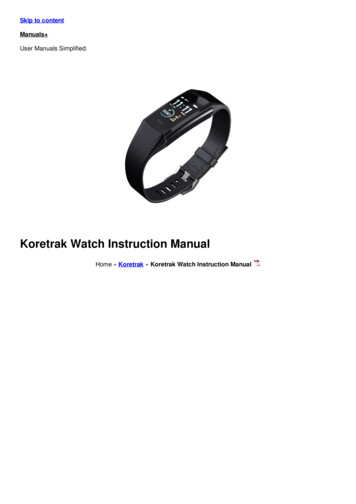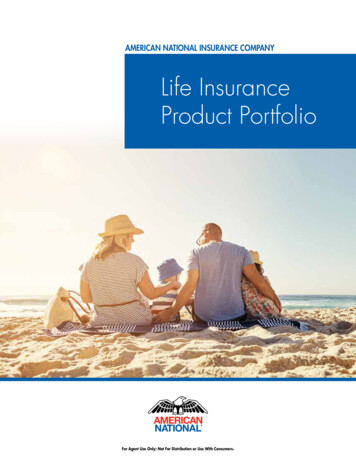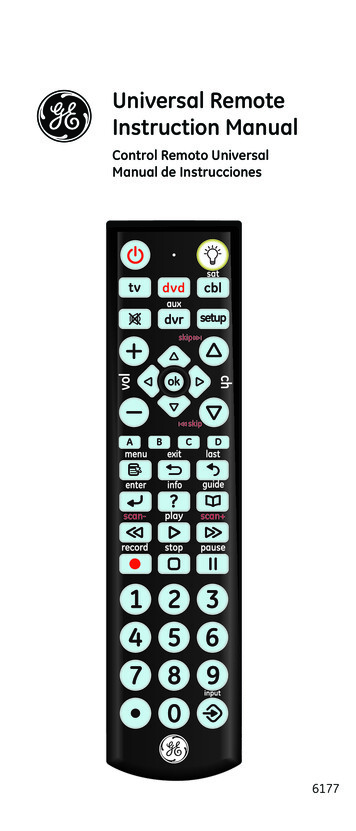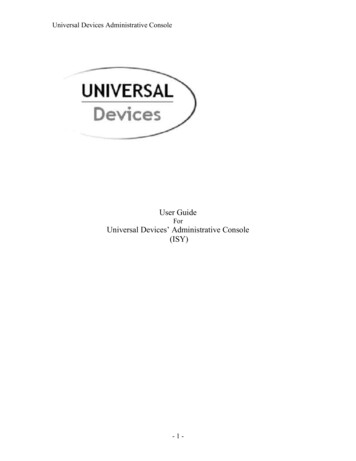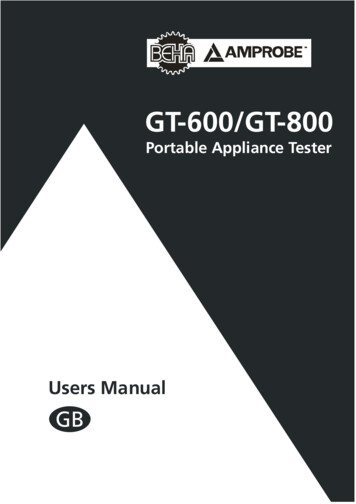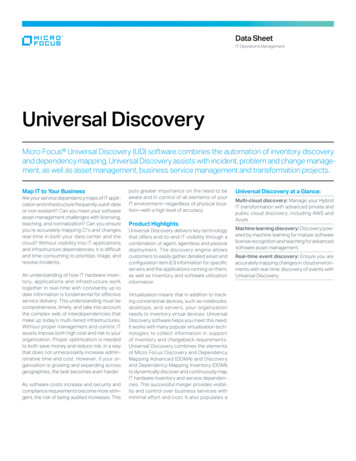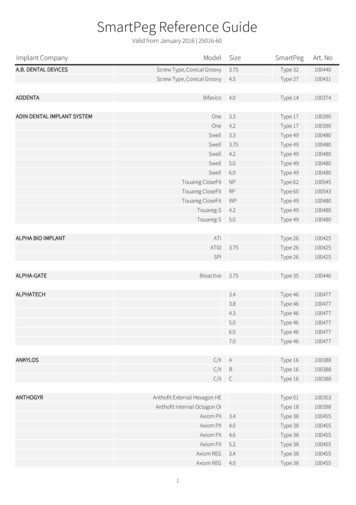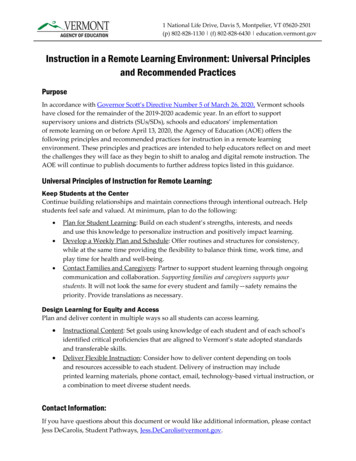
Transcription
1 National Life Drive, Davis 5, Montpelier, VT 05620-2501(p) 802-828-1130 (f) 802-828-6430 education.vermont.govInstruction in a Remote Learning Environment: Universal Principlesand Recommended PracticesPurposeIn accordance with Governor Scott’s Directive Number 5 of March 26, 2020, Vermont schoolshave closed for the remainder of the 2019-2020 academic year. In an effort to supportsupervisory unions and districts (SUs/SDs), schools and educators’ implementationof remote learning on or before April 13, 2020, the Agency of Education (AOE) offers thefollowing principles and recommended practices for instruction in a remote learningenvironment. These principles and practices are intended to help educators reflect on and meetthe challenges they will face as they begin to shift to analog and digital remote instruction. TheAOE will continue to publish documents to further address topics listed in this guidance.Universal Principles of Instruction for Remote Learning:Keep Students at the CenterContinue building relationships and maintain connections through intentional outreach. Helpstudents feel safe and valued. At minimum, plan to do the following: Plan for Student Learning: Build on each student’s strengths, interests, and needsand use this knowledge to personalize instruction and positively impact learning.Develop a Weekly Plan and Schedule: Offer routines and structures for consistency,while at the same time providing the flexibility to balance think time, work time, andplay time for health and well-being.Contact Families and Caregivers: Partner to support student learning through ongoingcommunication and collaboration. Supporting families and caregivers supports yourstudents. It will not look the same for every student and family—safety remains thepriority. Provide translations as necessary.Design Learning for Equity and AccessPlan and deliver content in multiple ways so all students can access learning. Instructional Content: Set goals using knowledge of each student and of each school’sidentified critical proficiencies that are aligned to Vermont’s state adopted standardsand transferable skills.Deliver Flexible Instruction: Consider how to deliver content depending on toolsand resources accessible to each student. Delivery of instruction may includeprinted learning materials, phone contact, email, technology-based virtual instruction, ora combination to meet diverse student needs.Contact Information:If you have questions about this document or would like additional information, please contactJess DeCarolis, Student Pathways, Jess.DeCarolis@vermont.gov.
Engage Families and Caregivers: Communicate with families and caregivers aboutengagement strategies to support students as they access the learning. Families arecritical partners. Provide translations as necessaryAssess Student LearningManage and monitor student learning and plan what’s next for learning. Check Student Learning: Use a variety of strategies to monitor, assess, andprovide feedback to students about their learning.Make Instructional Adjustments: Use formative assessment results toguide student reflection on effectiveness of instruction and to determine next steps forstudent learning.Engage Families and Caregivers: Communicate with and seek input from families andcaregivers about assessment results in order to inform next steps. Provide translations asnecessary.For additional information see Assessment in a Remote Learning Environment: RecommendedPractices.Recommended Practices for Remote Learning:Lesson PlanningDisruptions due to school closure of schools can impact student availability and their schedules.When planning remote lessons, teachers need to take a less-is-moreapproach. Identifying those critical academic proficiencies and transferable skills which allowfor more flexibility for student pacing is essential. A schoolwide/district-wide approach todetermining critical proficiencies ensures consistency across grade levels and content areas.Consider whether a student continually needs to meet synchronously with a teacher for ascheduled check-in or virtual lecture, or whether learning can occur over a given time frame bythe student from previously prepared lessons and resources. An asynchronous approach toremote learning allows students to progress at their own pace, and helps shiftteachers from distributors of knowledge to designers of experiences and facilitators of learning.The following is a recommendation of the maximum time of academic engagement by eachstudent in remote learning activities:Total Daily Maximum Academic Engagement Time K-2: 90 min/day 3-5: 120 min/day 6-8: 180 min/day 9-12: 270 min/dayInstruction in a Remote LearningEnvironment: Universal Principles andRecommended Practices(Revised: April 8, 2020)Page 2 of 6
Digital Guidelines: Provide learning opportunities that balance structured, synchronouslearning experiences with flexible, asynchronous learning experiences.Consider leveraging low bandwidth options like WhatsApp and Google Forms, andminimize usage of high bandwidth/data attachments or videos when possible.When planning, use technology intentionally to ensure the online lesson continues toalign to the learning objective.When planning an online lesson, consider the student audience and the balanceof media students will encounter (documents, audio, slides, video,websites, discussion boards, pictures, live chats) and minimize heavy reliance on onemedia over others.Prepare your learning and teaching space by minimizing the distractions around youwhile you work. Consider your backdrop, camera angle and lighting.Recognize that teaching face-to-face allows for a certain amount of improv, includingspur-of-the-moment changes to lessons. Online teaching requires more up-front work,particularly when designing course materials.Plan for “unplugged” learning to promote healthy technology usage for all students.Continue or consider planning lessons in conjunction with paraprofessionals,multilingual staff, special educators, or any other related service providers.Recognize that while routine and normalcy are important in students’ lives, this may bethe moment to further teaching practice by taking risks in designing newinterdisciplinary learning experiences for students.The Vermont Agency of Education will be scaling its existing relationship with Vermont VirtualLearning Cooperative (VTVLC) to provide an optional online system to schools that willprovide access to curated and standards-based curriculum and instruction for English languagearts, social studies, math, science and health/PE to support continuity of learning for ourstudents and school communities. This is targeted to serve secondary students beginning atgrade 6 for the remainder of the school year. This option will be at no cost to schools or families.Analog Guidelines Create or select learning opportunities connected to students’ current reality.Take advantage of project-based learning to integrate content in meaningful ways.Provide hard copies of instructions that are free of jargon.Incorporate freely available resources like PBS programming and activities into the day.Incorporate opportunities for students to use transferable skills, especiallycommunication, self-direction, and problem solving.Invite families and caregivers into the learning space and activities.Encourage students to use a variety of strategies to demonstrate what they havelearned.Instruction in a Remote LearningEnvironment: Universal Principles andRecommended Practices(Revised: April 8, 2020)Page 3 of 6
In order to support the continuity of learning through analog options, the Vermont Agency ofEducation is partnering with the Vermont Public Broadcasting System (PBS). This partnershipwill provide access to free educational programming resources via television broadcasts.Additional resources will be provided by the AOE and Vermont PBS, both on-air and online.The PreK through grade 12 programming is aligned to national standards and includesinteractive lessons and suggested activities. PBS Plus (WGBH) has already begun airingeducational programming for grades 6-12 during the noon to 5 p.m. time slot; programming forPreK-8 will begin Monday, April 6, on the PBS main channel which is broadly availablethroughout the state and does not require cable.Personalized LearningRemote learning lends itself to providing opportunities for students to interact authenticallywith what they learn. When educators build asynchronous learning environments, studentshave more flexibility to move through content at their own pace. Creating a space for studentsto control how their education continues encourages them to be active learners in an analogor virtual space, rather than passive consumers of content. In addition, allowing students togive feedback on lessons can build trust and relationships in a remote learning environmentand actively build a supportive community. This also sets the stage for a new type ofrelationship and level of learning when students return to school.Digital and Analog Guidelines Elicit feedback from students to improve and reflect upon onlineteaching practices/styles, as well as lessons and assessments.Provide a variety of different resources or entry points to meet students’ readiness levelsand learning styles.Encourage students to problem solve with resources they may have access to.Leverage choice boards, interactive learning menus or parallel units that align to criticalproficiencies and transferable skills.Engage students in the lesson planning process by giving them opportunities to drivetopics that interest them.Create opportunities for students to engage in content and transferable skills usingcurrent events.CommunicationTeachers should have a consistent, concise, and accessible communication plan thatprioritizes responsive and timely feedback. Student connections with their teacher makelearners feel supported and connected, which is critical to their mental and emotional wellbeing. Responsive and timely feedback can help alleviate tension and stress when learners areworking in a remote environment.Instruction in a Remote LearningEnvironment: Universal Principles andRecommended Practices(Revised: April 8, 2020)Page 4 of 6
Digital Guidelines Ensure all students have access to information through at least one form ofcommunication (Mail, Phone Calls, Videos, Email, WhatsApp, Google Forms).Cleary define terms and/or ideas to avoid miscommunication.Establish norms for synchronous check in calls/video chats, or educator office hours.Assign note-takers and chat moderators to build community with student groupsduring synchronous check in calls/video chats.Remind students how to best communicate with their teacher and, when appropriate,peers.Develop guidelines for teacher response times and include all relevant staff members,especially paraprofessionals, multilingual staff, special educators, and any other relatedservice providers.Establish and follow any district guidelines and communication plans when needing toreport on student well-being or student crisis.Analog Guidelines Identify a process for making materials, including library books, available to families.Send home information that includes content represented through multiple modes (e.g.,text, diagram, graphic organizers and illustrations).Communicate clear expectations for assigned work.Leverage the SU/SDs mass communication resources to text students and families withlinks to content that are accessible by cellphone, when possible.Call students and their families and caregivers in order to maintain relationships.Provide families and caregivers with sample schedules that are balanced betweenindependent work and work supported by adults.While the transition from in-school teaching to remote teaching and learning will neither besimple nor easy, educators from across the country are rallying together to adjust their practicesto meet the needs of their students. Learning is a personal, lifelong process that leads to change,including the ability and willingness to adapt. Teachers, students and families are collaboratingtogether to design and implement systems of learning that will sustain students throughout theremainder of the school year, and perhaps provide new opportunities for students to learn inauthentic, meaningful ways.Resources for Remote LearningAs the demand for both internet access and available data has increased rapidly, manyproviders have responded with special offers. The offerings vary from free internet to unlimiteddata. Check with your local provider for offerings, or The Federal CommunicationsCommission, which has a list of companies and organizations that have signed the KeepInstruction in a Remote LearningEnvironment: Universal Principles andRecommended Practices(Revised: April 8, 2020)Page 5 of 6
Americans Connected Pledge. For Vermont-specific information, please visit the Departmentof Public Service website for information on new connectivity services.Please also see the AOE’s Continuity of Learning Guidelines for PK-5 Families and Continuityof Learning Guidelines for 6-12 Families.Digital Resources:Up and Running VTVLC WorkshopEnabling Distance Learning using Hangouts Meet from Google for EducationTips for Enabling Distance Learning through G Suite & ChromeRemote Learning Resources for PK-2Remote Learning Resources for Upper Elementary GradesBright by TextLearn at Home for All StudentsCOVID-19 Featured Resources from VTVLCCOVID-19: Featured Resources from NEASC14 Tips for Helping Students with Limited Internet Have Distance LearningDistance Learning: 6 UDL Best Practices for Online LearningIf you have questions about this document or would like additional information thefollowing AOE staff are available to support you:Margaret Carrera-Bly, Student Pathways, at Margaret.Carrera-Bly@vermont.govPat Fitzsimmons, Student Pathways, at Pat.Fitzsimmons@vermont.govRyan Parkman, Student Pathways, at Ryan.Parkman@vermont.govSigrid Olson, Student Pathways, at Sigrid.Olson@vermont.govInstruction in a Remote LearningEnvironment: Universal Principles andRecommended Practices(Revised: April 8, 2020)Page 6 of 6
environment. These principles and practices are intended to help educators reflect on and meet the challenges they will face as they begin to shift to analog and digital remote instruction. The AOE will continue to publish documents to further address topics listed in this guidance. Universal Principles of Instruction for Remote Learning:

